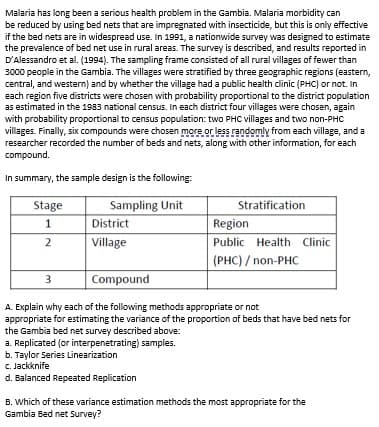the bed nets are in widespread use. In 1991, a nationwide survey was designed to estimate he prevalence of bed net use in rural areas. The survey is described, and results reported in Alessandro et al. (1994). The sampling frame consisted of all rural villages of fewer than 000 people in the Gambia. The villages were stratified by three geographic regions (eastern, entral, and western) and by whether the village had a public health clinic (PHC) or not. In ach region five districts were chosen with probability proportional to the district population s estimated in the 1983 national census. In each district four villages were chosen, again with probability proportional to census population: two PHC villages and two non-PHC illages. Finally, six compounds were chosen more or less randomly from each village, and a esearcher recorded the number of beds and nets, along with other information, for each compound. summary, the sample design is the following:
the bed nets are in widespread use. In 1991, a nationwide survey was designed to estimate he prevalence of bed net use in rural areas. The survey is described, and results reported in Alessandro et al. (1994). The sampling frame consisted of all rural villages of fewer than 000 people in the Gambia. The villages were stratified by three geographic regions (eastern, entral, and western) and by whether the village had a public health clinic (PHC) or not. In ach region five districts were chosen with probability proportional to the district population s estimated in the 1983 national census. In each district four villages were chosen, again with probability proportional to census population: two PHC villages and two non-PHC illages. Finally, six compounds were chosen more or less randomly from each village, and a esearcher recorded the number of beds and nets, along with other information, for each compound. summary, the sample design is the following:
Holt Mcdougal Larson Pre-algebra: Student Edition 2012
1st Edition
ISBN:9780547587776
Author:HOLT MCDOUGAL
Publisher:HOLT MCDOUGAL
Chapter11: Data Analysis And Probability
Section11.4: Collecting Data
Problem 2E
Related questions
Question

Transcribed Image Text:Malaria has long been a serious health problem in the Gambia. Malaria morbidity can
be reduced by using bed nets that are impregnated with insecticide, but this is only effective
if the bed nets are in widespread use. In 1991, a nationwide survey was designed to estimate
the prevalence of bed net use in rural areas. The survey is described, and results reported in
D'Alessandro et al. (1994). The sampling frame consisted of all rural villages of fewer than
3000 people in the Gambia. The villages were stratified by three geographic regions (eastern,
central, and western) and by whether the village had a public health clinic (PHC) or not. In
each region five districts were chosen with probability proportional to the district population
as estimated in the 1983 national census. In each district four villages were chosen, again
with probability proportional to census population: two PHC villages and two non-PHC
villages. Finally, six compounds were chosen more or less randomly from each village, and a
researcher recorded the number of beds and nets, along with other information, for each
compound.
In summary, the sample design is the following:
Stage
Sampling Unit
Stratification
1
District
Region
Village
Public Health Clinic
(PHC)/non-PHC
3
Compound
A. Explain why each of the following methods appropriate or not
appropriate for estimating the variance of the proportion of beds that have bed nets for
the Gambia bed net survey described above:
a. Replicated (or interpenetrating) samples.
b. Taylor Series Linearization
c. Jackknife
d. Balanced Repeated Replication
B. Which of these variance estimation methods the most appropriate for the
Gambia Bed net Survey?
2
Expert Solution
This question has been solved!
Explore an expertly crafted, step-by-step solution for a thorough understanding of key concepts.
Step by step
Solved in 3 steps with 2 images

Recommended textbooks for you

Holt Mcdougal Larson Pre-algebra: Student Edition…
Algebra
ISBN:
9780547587776
Author:
HOLT MCDOUGAL
Publisher:
HOLT MCDOUGAL

College Algebra (MindTap Course List)
Algebra
ISBN:
9781305652231
Author:
R. David Gustafson, Jeff Hughes
Publisher:
Cengage Learning


Holt Mcdougal Larson Pre-algebra: Student Edition…
Algebra
ISBN:
9780547587776
Author:
HOLT MCDOUGAL
Publisher:
HOLT MCDOUGAL

College Algebra (MindTap Course List)
Algebra
ISBN:
9781305652231
Author:
R. David Gustafson, Jeff Hughes
Publisher:
Cengage Learning
